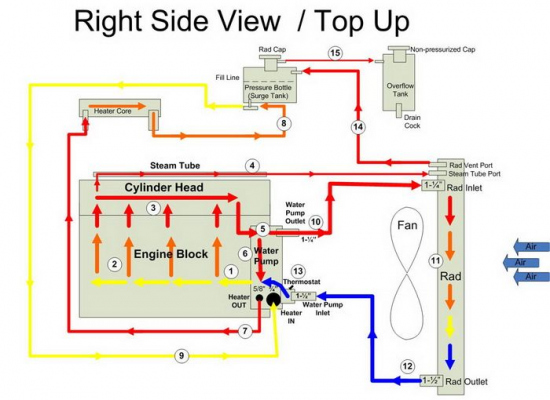Coolant is drawn from the radiator outlet and into the water pump inlet by the water pump. Coolant will then be pumped through the water pump outlet and into the engine block. In the engine block, the coolant circulates through the water pump outlet and into the engine block. In the engine block, the coolant circulates through the water jackets surrounding the cylinders, where it absorbs heat. Some coolant is also pumped from the water pump to the heater core, then back to the water pump. This provides the passenger compartment with heat and defrost. The coolant is then forced through the cylinder head gasket openings and into the cylinder heads. In the cylinder heads, the coolant flows through the water jackets surrounding the combustion chambers and valve seats, where it absorbs additional heat. Coolant is also directed to the throttle body. There it circulates through passages in the casting. During initial start up, the coolant assists in warming the throttle body. During normal operating temperatures, the coolant assists in regulating the throttle body temperature.
The surge tank is a plastic tank with a threaded pressure cap. The tank is mounted at a point higher than all other coolant passages. The surge tank provides an air space in the cooling system that allows the coolant to expand and contract. The surge tank provides a coolant fill point and a central air bleed location. During vehicle use, the coolant heats and expands.
The increased coolant volume flows into the surge tank. As the coolant circulates, any air is allowed to bubble out. Coolant without air bubbles absorbs heat much better than coolant with bubbles.
The water pump is a centrifugal vane impeller type pump. The pump consists of a housing with coolant inlet and outlet passages and an impeller. The impeller is mounted on the pump shaft and consists of a series of flat or curved blades or vanes on a flat plate. When the impeller rotates, the coolant between the vanes is thrown outward by centrifugal force.
The thermostat is a coolant flow control component. It's purpose is to help regulate the operating temperature of the engine. It utilizes a temperature sensitive wax-pellet element. The element connects to a valve through a small piston. When the element is heated, it expands and exerts pressure against the small piston. This pressure forces the valve to open. As the element is cooled, it contracts. This contraction allows a spring to push the valve closed. When the coolant temperature is below the rated thermostat opening temperature, the thermostat valve remains closed. This prevents circulation of the coolant to the radiator and allows the engine to warm up. After the coolant temperature reaches the rated thermostat opening temperature, the thermostat valve will open. The coolant is then allowed to circulate through the thermostat to the radiator where the engine heat is dissipated to the atmosphere. The thermostat also provides a restriction in the cooling system, after it has opened. This restriction creates a pressure difference which prevents cavitation at the water pump and forces coolant to circulate through the engine block.
sourced from Service and repair manual beginning on page 3536 of 9979 pages.


